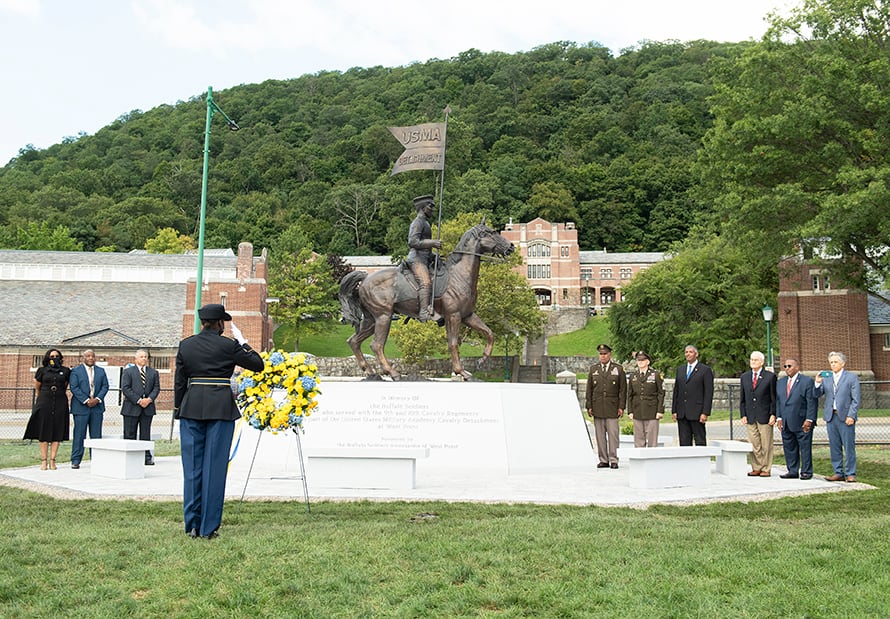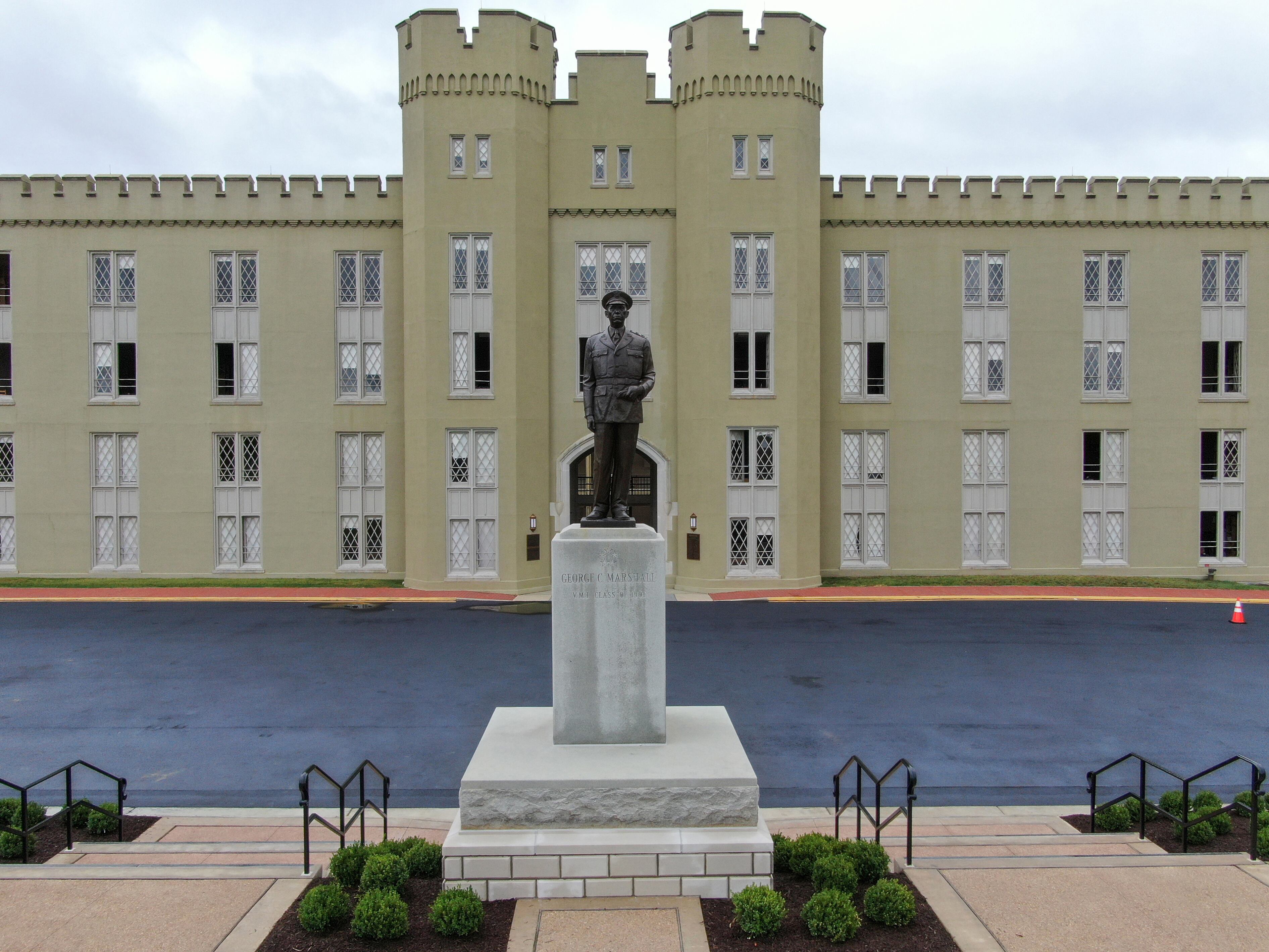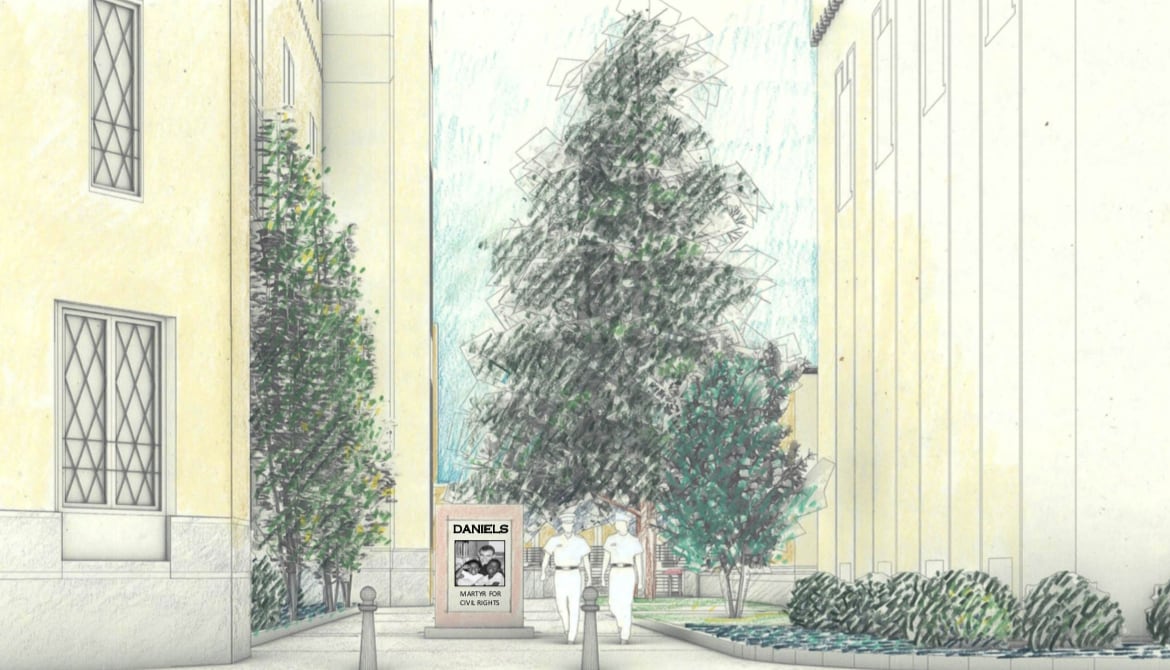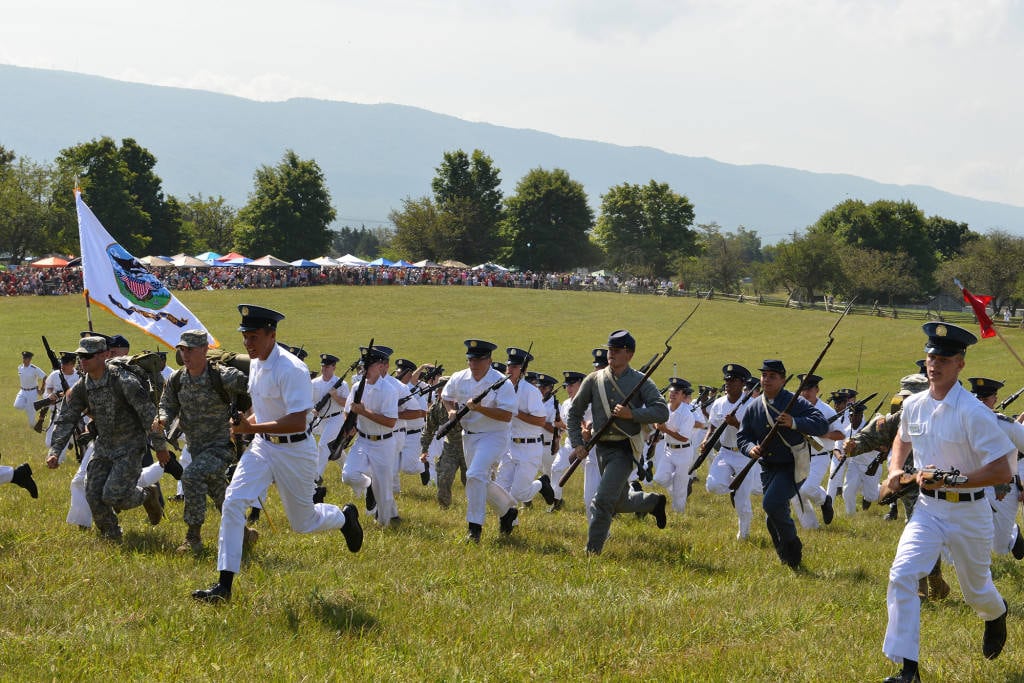LEXINGTON, Va. — Two of the Army’s oldest sources of young officers are going beyond simple removal of Confederate symbols as they rethink the way their landscapes, buildings and statues influence their students.
The reckoning comes amid a congressionally mandated review of the Defense Department’s Confederate objects and names, in addition to stricter scrutiny from state governments and the broader public.
For the U.S. Military Academy at West Point, this means adding new statues and changing a few names. But for the Virginia Military Institute — sometimes called “the West Point of the Confederacy” — the task is much more complicated.
Earlier this month, the Army unveiled a new monument at West Point. It honors the Black soldiers who helped train cadets in horsemanship from 1907 to 1941. The bronze monument, donated by the Buffalo Soldiers Association of West Point, depicts a ten-foot tall Black cavalry trooper on horseback.
“The battles fought by the Buffalo Soldiers from 1866 to 1947 were many, and their accomplishments were storied,” said retired Gen. Vincent Brooks, who presided over the ceremony unveiling the monument at West Point. “All the while one particular battle went with them no matter what the location was — the battle against institutional racism.”
The Buffalo Soldiers worked daily with some of the Army’s World War II luminaries during their formative years, including George S. Patton, Dwight D. Eisenhower and Omar Bradley.
“These Soldiers embodied the West Point motto of Duty, Honor, Country and ideals of the Army Ethic,” said the academy’s superintendent, Lt. Gen. Darryl Williams, in a press release. “This monument will ensure that the legacy of Buffalo Soldiers is enduringly revered, honored and celebrated while serving as an inspiration for the next generations of cadets.”

The new monument comes as the Army’s service academy prepares to rename one of its dormitories, a road and a gate that are all named for Robert E. Lee, the former West Point superintendent who rose in fame when he chose to lead secessionist Confederate forces.
Over the past year, the landscape of the Virginia Military Institute has also rapidly transformed as its new leadership looks to different historical figures to inspire its student body after publicly backing away from its former deification of Thomas “Stonewall” Jackson.
Jackson was a legendary Confederate commander who was a “mediocre” faculty member at VMI for a decade before the war, according to an archived version of the school’s website.
Cadets once saluted a Jackson statue from its erection in 1912 until the tradition was banned in 2015. The school removed the statue late last year. Recently, the school’s governing Board of Visitors voted to remove his name from buildings, quotes and other inscriptions on campus.
Because it is a state university rather than a DoD institution like West Point, VMI is exempt from the DoD ban on Confederate symbols and the Naming Commission’s reviews.
But that hasn’t stopped the nation’s oldest state-run military school from receiving withering criticism of its previous handling of its Civil War heritage. Law firm Barnes & Thornburg submitted a report detailing a “racist and sexist culture” at VMI to the Virginia state legislature this summer.
The report described how some in the VMI community “found the [Confederate] iconography and traditions to be degrading,” especially cadets and graduates of color.
The report also found that continued “emphasis on Confederate symbols and support for the Confederacy” would make it more difficult to recruit and retain cadets of color. The report recommended that the school deemphasize its Confederate heritage in favor of other prominent VMI alumni.
Army Times spoke with VMI officials — including its superintendent and longtime director of its museum system — about their efforts to reshape the school’s landscape and bronze statues despite outcry from a vocal minority of alumni.
The school’s governing Board of Visitors has established a committee that is reviewing VMI’s voluminous Confederate iconography as a starting point for working towards the report’s recommendation.
The superintendent, retired Army Maj. Gen. Cedric Wins, says the moves are meant to be part of creating a more “welcoming” environment for developing future leaders — 55 percent of VMI graduates accept commissions in the U.S. military.
Wins, the first Black man to lead VMI, graduated from the school in 1985. He took the reins as interim superintendent in November 2020, after his predecessor was forced to resign amid controversy over systemic racism allegations brought to light in the Washington Post. The Board of Visitors confirmed Wins’ permanent appointment in April.
“We want young men and young women…to be able to come here and find the environment welcoming, because that, I believe, is what best ensures their ability to find their place,” Wins told Army Times in a Friday interview. “[We want them to] find out where they want to achieve excellence, what they want to strive to be.”
Even as the committee continues its work, which VMI Museum System director Keith Gibson says will be complete by May 2022, VMI has already made one major reorientation in its commemorative landscape.
Gibson, a 1977 graduate of VMI, is a former Navy officer. He joined the VMI Museum staff in 1986 and now oversees its three museums. As is standard practice with VMI administrators, he holds a commission as a colonel in the Virginia State Militia.
In December, the school removed the Jackson statue that stood prominently by its parade field and received mandatory salutes from passing cadets until 2015, Gibson explained.
The parade field, after some reshuffling of flagpoles and landscaping, is now centered on a plaza featuring a bronze statue of Gen. George C. Marshall, a 1901 VMI alum.
Marshall went on to serve as the Army’s chief of staff throughout World War II before becoming secretary of state and overseeing the rebuilding of Europe after the war. Now, passing first-year cadets salute Marshall.
“We’ve re-envisioned and centered our barracks front on the Marshall statue, where it’s bookended by two flag poles,” explained Wins. “That’s a reminder of a significant alum who did some consequential things at a time that I think we can all recognize was important to the continued development and success of the United States of America.”

“I’ve never felt the way it was positioned before [the shift] gave Marshall his just recognition and acknowledgement,” said Gibson. “We have now had that opportunity [with the removal of Jackson] to…give [the statue] the prominence that Marshall deserves.”
The school also plans to expand its existing memorial space honoring Jonathan Daniels, valedictorian of VMI’s 1961 class and Episcopalian civil rights martyr.
Daniels, who participated in the second Selma to Montgomery march and then stayed in Alabama to continue his activism, died in 1965 while shielding a Black civil rights activist from a white man infuriated over their attempt to enter a store.
Martin Luther King Jr. later described Daniels’ actions as “One of the most heroic Christian deeds of which I have heard in my entire ministry.”
VMI will erect a monument to Daniels that will serve as a gateway to an expanded memorial plaza and will double as an outdoor classroom space, Gibson and Wins said.
Marshall and Daniels offer a better aspirational ideal for the school’s cadets and are more worthy of places of honor on campus than Jackson and the other Confederate icons on campus, Gibson told Army Times during a Thursday morning tour.
“These are really meaningful changes that, in their totality, once complete, are going to be evocative of a well-rounded, fuller ideal of what we would want a VMI graduate to go on to do,” Gibson told Army Times. “The world is changing. The culture is changing. And VMI graduates have to be prepared to take their place in that new environment.”

But VMI’s Confederate history goes beyond bronze and granite, extending into the realm of tradition. The entire student body was sworn into Confederate service ahead of the 1864 Battle of New Market, where 10 cadets died in a bayonet charge that helped secure victory over the Union Army that day.
The New Market cadets are considered a cornerstone of VMI tradition and legacy — first year cadets, known as “rats,” are traditionally forced to memorize their names. Rats also used to take their cadet oath following a reenactment of the bayonet charge at the historic New Market battlefield, where VMI operates the Virginia Museum of the Civil War.
It’s a complicated legacy, and VMI has faced criticism in the past for its role in promulgating the false narrative of the “Lost Cause,” which holds that the Civil War was not fought over the issue of slavery. In the Barnes & Thornburg report, many recent graduates expressed their frustration with the way VMI history courses downplayed the role of slavery in sparking the war.
Those traditions are changing, Gibson and Wins said, but won’t be thrown out entirely.
No longer will new Rats take their oath after charging the “Field of Lost Shoes” at New Market, as Wins did in 1980 during his first year, nor will the institute host a battle reenactment there, Gibson added.
“We have been reviewing that very seriously every year for at least 15 years,” Gibson said. “There began to be more cons [to holding the events] than pros.”
Then the COVID-19 pandemic showed that the historical park and museum could survive without the reenactment events, “and so we made the decision to terminate that living history event,” Gibson explained.
The school has also expanded traditional commemorative roll calls that took place annually on the anniversary of the battle to now include all of VMI’s wartime dead throughout its history rather than just the ten who died at New Market, six of whom are buried on campus. This includes a new and expanded interpretation of a landmark statue on campus, Virginia Mourning Her Dead, to include VMI graduates who have died in combat in all American conflicts.
To Gibson and Wins, the New Market story is one of cadet solidarity and camaraderie, immortalized by a giant mural hanging in the school’s Memorial Hall. They think they can divorce it, as well as other reminders of it on campus, from the greater context of the war so that cadets can continue to draw lessons from their forebears.
“I think there’s a story that can be told about the character of young men who answered the call, not being in a position to make a decision of necessarily right or wrong,” explained Wins.
He said when he charged the New Market field in 1980, he was “a young and impressionable 18-year old...[who] was just trying to make it through this place.”

Wins also pushed back on the idea of fully evaluating the school’s own role in perpetuating the Lost Cause. He argued that curriculum changes underway and the evolving interpretation in the school’s museum system might be enough.
“Whether or not we have to have a confessional about VMI’s role in the Lost Cause, I’m not too certain about [that],” the superintendent said. “We need to make sure that the things that are fundamental to our mission are consistent with the development of young men and women who are capable of being leaders in a very diverse and complex world today.”
VMI faces perhaps the most complicated path forward of any of the Army’s six senior military colleges thanks to the depth of its connections to its Confederate legacy, to include the very ground it stands on. Its educational neighbor in the sleepy rural town of Lexington is Washington & Lee University, whose board recently voted overwhelmingly to retain its name honoring the Confederate general who served as the university’s president after the war.
Most of “Stonewall” Jackson, less his left arm, is buried down the street in a cemetery that bore his name until recently. Lee is also buried in town on W&L campus.
The town also celebrates “Lee-Jackson Day” annually on Martin Luther King Jr. weekend, though the state abolished the holiday in 2020. That did not stop this year’s festivities.
Virginia’s leaders have made it clear that VMI’s state funding is at stake if the institute doesn’t improve its experience for cadets of color and women — 14 percent of whom reported experiencing sexual assault while at VMI, according to the Barnes & Thornburg report.
Wins’ advocates argue he is the right man to lead this transformation, given his experience and confluence of identities that resonate with many of the school’s stakeholders. He’s a 1985 graduate of VMI, a Black man, a retired general officer and a first-generation college graduate.
“There’s many things that have helped me bring a different perspective — or at least my perspective — of how VMI needs to operate in the 21st century, to continue to produce the type of leaders that we believe are important to the nation,” he acknowledged.
But will he succeed, and will he be able to usher a sufficiently broad reckoning to preserve the nation’s oldest state military college? Only time — or perhaps VMI alum and Virginia governor Ralph Northam — will tell.
Davis Winkie covers the Army for Military Times. He studied history at Vanderbilt and UNC-Chapel Hill, and served five years in the Army Guard. His investigations earned the Society of Professional Journalists' 2023 Sunshine Award and consecutive Military Reporters and Editors honors, among others. Davis was also a 2022 Livingston Awards finalist.




